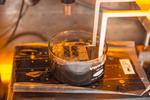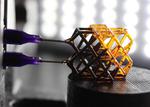Other
News 3D-printed live cells convert glucose to ethanol, carbon dioxide to enhance catalytic efficiency

“Lawrence Livermore National Laboratory (LLNL) researchers have 3D printed live cells that convert glucose to ethanol and carbon dioxide gas (CO2), a substance that resembles beer, demonstrating a technology that can lead to high biocatalytic efficiency. Bioprinting living mammalian cells …

“Lawrence Livermore National Laboratory (LLNL) scientists and engineers have created the first research-grade, open-architecture multibeam metal 3D printer and are developing advanced diagnostics to understand the mechanics behind the multibeam process under a project funded by the Air Force Research …
News Researchers look to computing’s past to unlock 3D-printed mechanical logic gates for the future

“Taking a page from the past, Lawrence Livermore National Laboratory scientists and engineers are combining mechanical computing with 3D printing as part of an effort to create “sentient” materials that can respond to changes in their surroundings, even in extreme …

“Lawrence Livermore National Laboratory (LLNL) researchers have introduced a new class of metamaterials that can nearly instantly respond and stiffen 3D-printed structures when exposed to a magnetic field, a development that could be applied to next-generation helmets, wearable armor and …

“What would it take for an entire American city to lose power? What circumstances and failures in the electrical grid’s infrastructure would lead to a dramatic, long-term blackout? And what weak points could utility companies invest in to help …

“Scientists revise understanding of the limits of bonding for very electron-rich heavy elements. The Science Actinides, a series of 15 radioactive elements, are vital to medicine, energy, and national defense. Scientists examined two exceedingly rare actinides, berkelium and californium. These …

“Lawrence Livermore National Laboratory (LLNL) researchers are working to make better electronic devices by delving into the way nanocrystals are arranged inside of them. Nanocrystals are promising building blocks for new and improved electronic devices, due to their size-tunable properties …

“Advances in supercapacitor technology could lead to wider use of fast-charging energy storage devices and novel designs for electronic gadgets Scientists at UC Santa Cruz and Lawrence Livermore National Laboratory (LLNL) have reported unprecedented performance results for a supercapacitor electrode …

“For years, Lawrence Livermore National Laboratory engineers and scientists have used an array of sensors and imaging techniques to analyze the physics and processes behind metal 3D printing in an ongoing effort to build higher quality metal parts the first …

“Lawrence Livermore National Laboratory (LLNL) engineers and scientists have developed a new technique that enhances the performance of Lab-developed flexible thin-film biological sensors, increasing the sensitivity of the implantable arrays to chemicals for biosensing applications, among other performance improvements. In …
